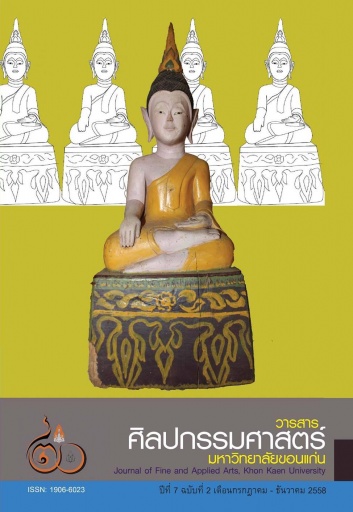ภาพทศชาติชาดก ภาพสะท้อนการสืบทอดศาสนาในจิตรกรรมอีสานช่างท้องถิ่น กรณีศึกษาจังหวัดร้อยเอ็ด The ten incarnations of the Buddha on mural paintings: A display of how the artists in north-eastern Thailand preserved their religion. A case study in Roi Et provin
Main Article Content
Abstract
ภาพทศชาติชาดก ภาพสะท้อนการสืบทอดศาสนาในจิตรกรรมอีสานช่างท้องถิ่น กรณีศึกษาจังหวัดร้อยเอ็ด โดยภาพรวมทั้งหมดเป็นภาพจิตรกรรมที่มีอายุไม่เก่าเกินไปกว่า ช่วงปลายพุทธศตวรรษที่ 25 ถึงช่วงต้นพุทธศตวรรษที่ 26 จำแนกออกได้เป็นสองกลุ่มคือ กลุ่มอิทธิพลศิลปะกรุงเทพผสมศิลปะพื้นบ้าน และแบบพื้นบ้านแท้ ทั้งหมดเป็นฝีมือช่างพื้นถิ่นที่ว่าจ้างโดยชาวบ้านผู้มีจิตศรัทธามีส่วนรวมในการสร้างจิตรกรรมฝาผนังเพื่อสร้างบุญกุศลแก่ตนเองให้ถึงนิพพานและอุทิศญาติพี่น้องผู้ล่วงลับ
ทศชาติชาดกมีรูปแบบศิลปะโดยรวมสามารถเปรียบเทียบหรืออ้างอิงได้กับจิตกรรมไทยประเพณี แต่เมื่อเทียบช่วงระยะเวลาการสร้างรูปแบบตัวอย่างจิตรกรรมทั้งหมดจึงเป็นการย้อนไปเขียนรูปแบบและระเบียบอย่างเก่าครั้งสมัยจิตรกรรมประเพณีได้รับความนิยม ด้วยเนื้อหาส่วนรายละเอียดบางช่วงตอนของเวสสันดรชาดกที่ช่างพื้นถิ่นเน้นเขียนต่างออกไปได้แสดงถึงลักษณะเฉพาะที่เป็นแบบพื้นบ้านแท้จริงของจิตรกรรมอีสาน อิทธิพลและความสัมพันธ์ทางวรรณกรรมและประเพณีท้องถิ่นที่มีบทบาทส่งผลกับงานฮูปแต้มอีสาน จึงเห็นได้ว่าการใช้วรรณกรรมพื้นถิ่นที่แตกต่างกันในแต่ละท้องถิ่น ย่อมแสดงให้เห็นถึงลักษณะเฉพาะแต่ละท้องถิ่นนั้นซึ่งมีความสำคัญแตกต่างด้านวัฒนธรรม ความเชื่อ และยังช่วยสนับสนุนหรือชี้ข้อมูลให้เห็นว่าช่างผู้สร้างสรรค์หรือบุคคลสำคัญที่เกี่ยวข้องเป็นบุคลในท้องถิ่นนั้นด้วย
The ten incarnations of the Buddha on mural paintings: A display of how the artists in north-eastern Thailand preserved their religion. A case study in Roi Et province. All the murals in this case study are from after the late 25th – early 26th Century B.E.The people in north-east Thailand believed that painting the story of the Buddha would create good karma and help them and their families reach Nirvana someday. Local artists were hired to create the murals.
The murals were painted with a Rattanakosin (Bangkok) art style and can be separated into 2 groups. The first group shows the same story as traditional Bangkok murals, and the second group shows a slightly different story. After some research, we found that the differences mainly occur in the last story of “The ten incarnations of the Buddha” (Vessantara Jataka). The murals definitely show influences from local literature, culture, beliefs, artists and important people of the time.
Article Details
Content and information in articles published in the Journal of Fine and Applied Arts of Khon Kaen University is regarded as the opinion and sole responsibility of the author(s) directly; therefore, editors are not obliged to agree to or share any responsibility with regard to the content and information that appears within these articles.
All articles, information, content, image, etc. that have been published in the Journal of Fine and Applied Arts of Khon Kaen University is the copyright of the Journal of Fine and Appllied Arts of Khon Kaen University. Any person or organization who wishes to distribute all or parts of the articles for further dissemination or other usage must first receive permission from the Journal of Fine and Applied Arts of Khon Kaen University before proceeding to do so.


